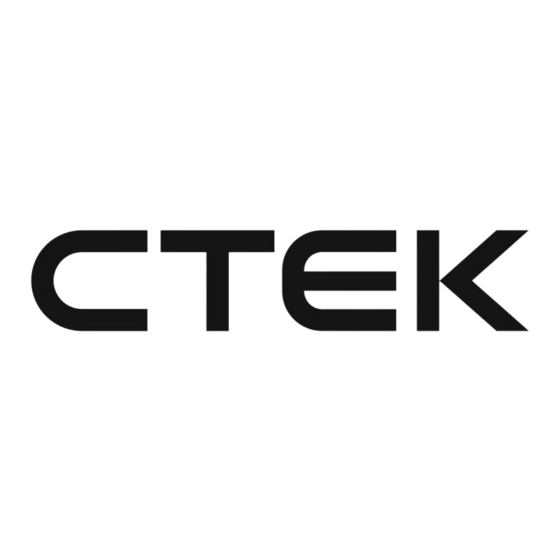
Table of Contents
Advertisement
Quick Links
MANUAL
CONGRATULATIONS
to the purchase of your new professional switch mode battery charger. This charger is
included in a series of professional chargers from CTEK SWEDEN AB and represents the
latest technology in battery charging.
SAFETY
• The charger is designed for charging only
batteries according to the technical specifica-
tion. Do not use the charger for any other
purpose. Always follow battery manufacturers
recommendations.
• Never try to charge non rechargeable batteries.
• Check the cables prior to use. Ensure that no
cracks have occurred in the cables or bend pro-
tection. A charger with damaged cables must
not be used. A damage cable must be replaced
by a CTEK representative.
• Never charge a damaged battery.
• Never charge a frozen battery.
• Never place the charger on top of the battery
when charging.
• Always provide for proper ventilation during
charging.
• Avoid covering the charger.
• A battery being charged could emit explosive
gases. Prevent sparks close to the battery.
• All batteries fail sooner or later. A battery that
fails during charging is normally taken care of
by the chargers advanced control, but some
rare errors in the battery could still exist. Don't
leave any battery during charging unattended
for a longer period of time.
• Ensure that the cabling does not jam or comes
into contact with hot surfaces or sharp edges.
• Battery acid is corrosive. Rinse immediately with
water if acid comes into contact with skin or
eyes, seek immediate medical advice.
EN • 3
Advertisement
Table of Contents

Subscribe to Our Youtube Channel
Summary of Contents for CTEK 1055
- Page 1 • Always provide for proper ventilation during to the purchase of your new professional switch mode battery charger. This charger is charging. included in a series of professional chargers from CTEK SWEDEN AB and represents the latest technology in battery charging. • Avoid covering the charger.
- Page 2 • Always check that the charger has switched to concerning use of the appliance in a safe way before leaving the charger unattended and and understand the hazards involved. Children connected for long periods. If the charger has shall not play with the appliance. Cleaning and not switched to within 36 hours, this is an user maintenance shall not be made by children...
-
Page 3: How To Charge
HOW TO CHARGE 1. Connect the charger to the battery. 2. Connect the charger to the wall socket. The power lamp will indicate that the mains cable is connected to the wall socket. The error lamp will indicate if the battery clamps are incorrectly connected. -
Page 4: Charging Programs
CHARGING PROGRAMS MAINS Settings are made by pressing the MODE-button. After about two seconds the charger CABLE activates the selected program. The selected program will be restarted next time the charger is connected. The table explains the different Charging Programs: Battery Program Explanation... -
Page 5: Error Lamp
The mains cable is connected to the wall socket. current ripple heats up the battery which has an aging effect on the positive electrode. High voltage ripple could harm other equipment that is connected to the battery. CTEK 2. FLASHING LIGHT: battery chargers produce very clean voltage and current with low ripple. -
Page 6: Charging Program
CHARGING PROGRAM DESULPHATION SOFT START BULK ABSORPTION ANALYSE RECOND FLOAT PULSE 14.4V 25A until 12.6V Increasing voltage 14.4V @ 25°C Checks if voltage 13.6V 12.9V‒14.4V to 14.4V @ 25°C Declining current drops to 12V NORMAL 18‒4.5A 14.4V 25A until 12.6V Increasing voltage 14.4V @ 25°C Checks if voltage... -
Page 7: Limited Warranty
Removing or damaging the seal will void the warranty. CTEK SWEDEN AB makes no warranty other than this limited warranty and is not liable for any costs other than those mentioned above, i.e. no consequential damages. Moreover, CTEK SWEDEN AB is not obligated to any warranty other than this warranty. - Page 8 10 • EN...
















Need help?
Do you have a question about the 1055 and is the answer not in the manual?
Questions and answers